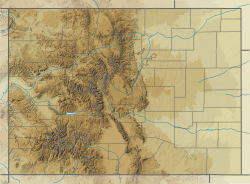Mesaverde Group
Group of geologic formations in the western United States From Wikipedia, the free encyclopedia
| Mesaverde Group | |
|---|---|
| Stratigraphic range: | |
 Mesaverde Group beds in the Book Cliffs near Helper, Utah. | |
| Type | Group |
| Sub-units | See text |
| Underlies | Lewis Shale, Meeteetse Formation, Datil Group (regionally) |
| Overlies | Cody Shale, Mancos Shale |
| Thickness | 200–400 metres (660–1,310 ft) |
| Lithology | |
| Primary | sandstone and shale |
| Other | coal |
| Location | |
| Coordinates | 37.316°N 108.419°W |
| Extent | New Mexico, Utah, Wyoming |
| Type section | |
| Named for | Mesa Verde, Colorado |
| Named by | W.H.Holmes (1877) |
History
Summarize
Perspective
The Mesaverde Formation was first described by W.H.Holmes in 1877 during the Hayden Survey. Holmes described the formation in the northern San Juan Basin as consisting of three units, which were a "Lower Escarpment" consisting of 40 m of ledge- and cliff-forming massive sandstone; a "Middle Coal Group" consisting of up to 300 m of thick slope-forming sandstone, shale, marl, and lignite; and an "Upper Escarpment" consisting of 60 m of ledge- and cliff-forming sandstone.[1] A.J. Collier redesignated these units in 1919 as the Point Lookout Sandstone, the Menefee Formation, and the Cliff House Sandstone, and raised the Mesaverde Formation to group rank.[2]
The group was later traced to the greater Green River Basin,[3] the Uintah and Piceance Basins,[4] the Bighorn Basin,[5] the Front Range,[6] the Zuni Basin,[7] the Wasatch Plateau,[8] Wind River Basin,[9] Washakie Basin,[10] and the Powder River Basin.[11] It is spectacularly exposed along the Book Cliffs of eastern Utah and western Colorado.[12] With the recognition of the vast extent of the group, the group has been divided into formations by region, with the original Point Lookout Sandstone, Menefee Formation, and Cliff House Sandstone being restricted largely to the San Juan Basin and the Madrid, New Mexico area.
Geology
Summarize
Perspective

The Mesaverde Group is a Late Cretaceous stratigraphic group found in areas of Colorado, New Mexico, Utah, and Wyoming, in the Western United States. The group is a single regression-transgression sequence in its type location in the San Juan Basin, dividing the older marine Mancos Shale and younger Lewis Shale deposited in the Western Interior Seaway. The Point Lookout Sandstone represents the regression, the Menefee Formation the subsequent fluvial delta deposits, and the Cliff House Sandstone the return of the sea. In other locations, such as along the Book Cliffs, the picture is more complicated, with multiple regression-transgression sequences from tectonic activity along the Sevier mountain front.[13] In the Cody area, the group is a simple regression sequence and remains at formation rank. Here the group is described as interbedded light gray sandstone and gray shale in the upper part; massive, light-buff, ledge-forming sandstone containing thin lenticular coal beds in the lower part.[14]
Formations

- Northern Piceance Basin:[15]
- southwestern Piceance Basin:[15]
- Hunter Canyon Formation
- Mount Garfield Formation
- Powder River Basin:[11]
- Teapot Sandstone
- Parkman Sandstone
- Northern San Juan Basin:[2]
- Point Lookout Sandstone
- Menefee Formation
- Cliff House Sandstone
- Southern San Juan Basin and southern New Mexico:[16][17]
- Point Lookout Sandstone
- Crevasse Canyon Formation
- Gallup Sandstone
- Uintah Basin:[18]
- Tuscher Formation
- Farrer Formation
- Neslen Formation
- Sego Sandstone
- Price River Formation
- Castlegate Sandstone
- Blackhawk Formation
- Star Point Sandstone
- Washakie Basin:[19]
- Almond Formation
- Ericson Sandstone
- Rock Springs Formation
- Blair Formation
Fossils
Dinosaur remains are among the fossils that have been recovered from the group, although none have yet been referred to a specific genus.[20] Deinosuchus has also been reported from Mesaverde outcrops in Wyoming.[21] In 2023, baenid turtle fossils tentatively assignable to Neurankylus sp. from the Mesaverde Formation were described.[22]
See also
Footnotes
Wikiwand - on
Seamless Wikipedia browsing. On steroids.


